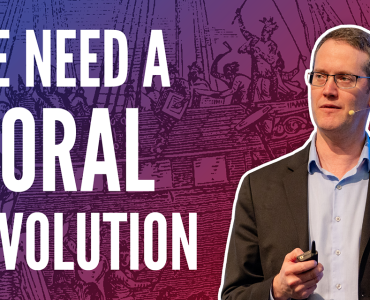Subscribe to the New Ideal podcast here.
By many of her fans and critics, Ayn Rand was often seen as belonging within the “conservative” movement. Isn’t her philosophy, people wondered, “just another form of conservatism”?1 That assumption outlived her. Rand’s ideas, one journalist claimed in 2019, are the intellectual backbone of everything that’s reprehensible about “conservatism.”
This linkage in the public mind has been reinforced by a number of conservative figures who are fans of The Fountainhead (Clarence Thomas) and Atlas Shrugged (Paul Ryan, Ted Cruz, among others). On the floor of the Senate in 2013, for instance, Sen. Cruz read aloud from Atlas Shrugged as part of a twenty-one-hour filibuster. Three years later, the initial members of President Donald Trump’s cabinet included several self-identified fans of Atlas Shrugged (Trump himself claimed to have read The Fountainhead).
But this association with “conservatism” is something Rand herself rejected. So what explains that persistent, though mistaken, linkage? Sometimes, it stems from superficial thinking, when critics attempt to squeeze Rand’s radical outlook into ready-made, conventional categories. Another explanation is rooted in the tribalism of today’s political landscape. For a growing number of people, you must belong to one or the other of the main political tribes. So the fact that Rand opposed “the left” (which she did) means she must be on “the right.” In many other cases, though, the explanation reflects a lack of knowledge (mingled with confusions) about Rand’s philosophy and, specifically, the basis of her critique of “conservatism.”
When we consider key points in Rand’s analysis of “conservatism,” in her writings and speeches between 1960 and 1981, it’s clear the disagreement goes deeper than any particular stand on policy.
Rand was not simply critical of “conservatism,” she repudiated it emphatically. Whereas she viewed the “liberals” of her time as morally corrupt for stealthily pushing the United States toward statism, Rand thought that there was something “more reprehensible still”: the attempt by “conservatives” to “defend freedom by stealth.”2
What was she objecting to, and why?
Freedom’s missing moral foundation
Rand’s evaluation of “conservatism” was framed by her distinctive philosophic view of the foundations of a free society.3 The American system, she observed, was the culmination of centuries of intellectual, philosophical development, a long struggle “stretching from Aristotle to John Locke to the Founding Fathers.” Deeply influenced by the Enlightenment, the Founders created a government based on the principle of individual rights.
But this spectacular political-economic achievement — which “created the highest standard of living ever known on earth”4 — rested on a moral foundation that was only ever implicit. It was never given a full, consistent, explicit philosophic defense. Such a defense entails advocating the moral ideal of individualism; it entails upholding the individual’s “right to his own life, to his own liberty, to the pursuit of his own happiness.”5 But the system of capitalism, Rand argued, was perishing for lack of such a moral defense.
Conservatives are paralyzed by the profound conflict between capitalism and the moral code which dominates our culture: the morality of altruism.
For Americans in the 1960s, listening to leaders and spokesmen of “conservatism,” it was natural to think of that movement as advocating freedom. Three positions widely associated with “conservatism” at the time were (a) an opposition to the global spread of Communism, (b) the idea of “limited government,” and (c) opposition to the “liberals,” coupled with a suspicion of welfare-state programs. Even if in the public mind “conservatism” was thought to mean a stand for capitalism, the movement encompassed different factions and groups, and it has forever been haunted by the question of what it stands for.
On what grounds did “conservatives” oppose the spread of Communism? What is a “limited government”? What was the nature of their opposition to welfare programs? What affirmative positions did “conservatism” advocate? What intellectual foundation did thinkers and leaders of the movement rely on to justify their positions? How solid was it?
Evading the moral issue
The title of a 1960 lecture that Rand gave at Princeton University intimated her view of the movement: “Conservatism: An Obituary.” In her assessment, where there should have been a clear, coherent, logical set of principles in defense of freedom, instead there was a void.
[C]apitalism is what the “conservatives” dare not advocate or defend. They are paralyzed by the profound conflict between capitalism and the moral code which dominates our culture: the morality of altruism. Altruism holds that man has no right to exist for his own sake, that service to others is the only justification of his existence, and that self-sacrifice is his highest moral duty, virtue, and value. Capitalism and altruism are incompatible; they are philosophical opposites; they cannot co-exist in the same man or in the same society.6
Understood properly, altruism is the premise behind every variant of socialism, fascism, Nazism, communism. Common to these political systems is the subjugation of the individual: “All of them treat man as a sacrificial animal to be immolated for the benefit of the group, the tribe, the society, the state.”7 To see a full, consistent political expression of altruism, consider the brutal tyranny of the Soviet Union.
By contrast the American system of government flowed from the opposite moral premise: the sanctity of an individual’s life and sovereign judgment. It was based, Rand observed, “on the principle of man’s inalienable right to his own life — which means: on the principle that man has the right to exist for his own sake, neither sacrificing himself to others nor sacrificing others to himself, and that men must deal with one another as traders, by voluntary choice to mutual benefit.”8
Yet this fundamental clash over moral ideas—ideas which “cannot co-exist in the same man or in the same society” — is precisely what “conservatives” struggled to evade or sidestep. Defending freedom would entail challenging the widely accepted ethics of altruism. Instead, “conservative” intellectuals and leaders deluded themselves that altruism was somehow compatible with freedom. Their evasiveness, Rand observed, cost them “their confidence, their courage, and their cause.”9
What “conservatives” projected was a “guilty evasiveness,” an “apologetic timidity,” and, crucially in Rand’s analysis, a “peculiarly non-intellectual, non-philosophical attitude” in their positions.
It also disarmed them. Having accepted the same moral ideas animating collectivists, “conservatives” were “unable to act and are merely reacting to the issues chosen and raised by the statists, thus accepting and helping to propagate the statists’ premises.”10 “Conservatives” were not opposed to regulation and the growth of entitlement programs on moral principle. Where they differed was on the concrete questions of implementation.
When the statists proclaim that their slave-system will achieve material prosperity, the “conservatives” concede it and rush to urge people to sacrifice their “materialistic” concerns in order to preserve freedom — thus helping the statists (and their own audiences) to evade the fact that only freedom makes it possible for men to achieve material prosperity. When the statists announce that our first duty is to support the entire population of the globe — the “conservatives” rush into debates on whether Asia, Africa or South America should be the first recipient of our handouts. When the statists set up a “Peace Corps” to send young Americans into unpaid (though tax-supported) servitude to foreign nations — “conservative” youth rush to propose an “effective Peace Corps.”11
What, then, was “conservatism” struggling to conserve? It was not capitalism, an idea that leading figures in the movement shied away from even talking about.12 They wanted to preserve the status quo, a system with elements of freedom and welfare statism, which Rand called the “mixed economy.” What “conservatives” projected was a “guilty evasiveness,” an “apologetic timidity,” and, crucially in Rand’s analysis, a “peculiarly non-intellectual, non-philosophical attitude” in their positions.13
Abandoning reason
The movement’s anti-intellectualism was evident in “conservative” defenses of freedom. In “Conservatism: An Obituary,” Rand looks at three related arguments which she designated as the argument from faith, the argument from tradition, and the argument from depravity. What they reveal is an abandonment of reason.
To defend “freedom” by appeal to faith is to invoke the supernatural, to regress to a pre-scientific justification. It is to confess that there are no rational arguments, no evidence, no logic for one’s position. The “conservative” argument from faith, Rand argued, granted enemies of freedom an unearned moral-intellectual superiority. Note that at the time, socialist thinkers had arrogated to themselves the mantle of rationality, science, human progress. That theme was echoed in Communist propaganda during the Cold War. To a significant extent, this deception worked. And “conservatives” helped it along. In Rand’s analysis, for “conservatives” to say that freedom rested on faith was to concede that facts, reason, and science were on the side of statism, collectivism, and dictatorship.
The “conservative” argument from tradition is another form of discarding reason. The fact that some belief is ancient, handed down as tradition, cannot be the standard of truth (consider the uncountable falsehoods that are ancient, such as the belief in sorcery, the geocentric model of the universe, or the divine right of kings). But crucially, when the Founders of America upheld the ideal of individual liberty, they were purposely breaking with political traditions.
The argument from depravity, Rand thought, was the worst of the three. The essential argument, she wrote, was that “since men are weak, fallible, non-omniscient and innately depraved, no man may be entrusted with the responsibility of being a dictator and of ruling everybody else; therefore, a free society is the proper way of life for imperfect creatures.” The implication is that dictatorship “is the result of faith in man and in man’s goodness; if people believed that man is depraved by nature, they would not entrust a dictator with power. This means that a belief in human depravity protects human freedom — that it is wrong to enslave the depraved, but would be right to enslave the virtuous.” On this line of thinking, dictatorships are a punishment for the sin of “relying on his intellect and of attempting to improve his life on earth” by trying to create a rational society.14
To accept this view is to hold that “humility, passivity, lethargic resignation and a belief in Original Sin are the bulwarks of capitalism.” Rand thought this particular argument exhibited a cynical contempt for all ideals and attempts to improve human life. “This is truly the voice of the Dark Ages rising again—in the midst of our industrial civilization.”15
The voice of the Dark Ages
The anti-intellectual trend that Rand had identified in the 1960s continued to influence “conservatism,” with ruinous effects that she had foreseen. In 1960 Rand briefly met and corresponded with Sen. Barry Goldwater, author of The Conscience of a Conservative and later a Republican presidential candidate. In a letter to Goldwater commenting on his book, Rand stressed that there can be “no more disastrous error — morally, philosophically and politically — than to assert that the ultimate justification of Capitalism rests on faith.”16
By 1980, in a dramatic expression of “conservatism’s” intellectual bankruptcy, the “voice of the Dark Ages” had risen to greater prominence and stridency.
While Ronald Reagan was on the campaign trail, the Atlanta Journal Constitution asked Rand about her view of him. Noting her refusal to vote for Reagan, she described him as the “representative of the worst kind of conservatism. I’m opposed to him on the same grounds as I’m opposed to conservatism, that is, to the mixture of religion and politics.” Although an atheist herself, she recognized an individual’s right to believe in religion, but held that “no one has the right to bring his religion into politics.”17
Rand rejected as immoral their crusade against a women’s right to abortion, describing the tag “pro-life” as dishonest.
Speaking at the Ford Hall Forum in Boston in 1981, Rand discussed the Reagan administration and, particularly, the rise of militant religionists within “conservatism.” What explained her distaste for President Reagan? It was “the philosophy he hasn’t got. I do not mean that I disagree with his philosophy; I mean that he hasn’t any.” What he seemed to believe in was an “awful, populist, religionist hodgepodge of stale patriotism and folksy sentimentality.”18
Militant religionists exist “in any period, in the dark, unventilated corners of history.” Their ascendancy, Rand thought, was symptomatic of a philosophical vacuum. The religionists had learned “to be arrogant by encountering no opposition.” Among these militant religionists she identified the self-proclaimed “Moral Majority” and the “pro-life” opponents of abortion.
The Reagan administration was culpable, in Rand’s view, for endorsing and supporting these religionists. Reagan supported some of their “ugliest demands, such as the anti-abortion issue and the ‘creationism’ issue.” Rand recoiled at the spectacle of an American president “endors[ing] the plain, crude, illiterate superstitions of the populace of the Middle Ages.”19
American ayatollahs
Judging by the aims of the “militant mystics” within “conservatism,” the anti-Enlightenment drift of that movement was becoming blatant. Rand rejected as immoral their crusade against a women’s right to abortion, describing the tag “pro-life” as dishonest. To prohibit a woman from deciding on her own life path — whether and, if so, when to have children — means robbing her of the sovereignty necessary to pursue her happiness. And Rand observed that their “pseudo-moral fervor” on this issue “derived from their religious tenets, which they are now flaunting in public.”
Religionists within “conservatism” were also trying to make the “family” a cultural issue. This campaign, with its invocations about honoring tradition, had gained salience over the years, and by 1981 Rand saw in it a repudiation of the American ideal of individualism. The militant religionist “worship of the ‘family’ is mini-racism, like a crudely primitive first installment on the worship of the tribe. It places the accident of birth above a man’s values, the unchosen ties of physical determinism above a man’s choices, and duty to the tribe above a man’s right to his own life.” The stress on “family” reflected an effort to “fill the conservatives’ moral vacuum.”
The notion of “creationism” was another major cause of religionists. To appreciate Rand’s assessment of it, recall how in the 1960s she decried “conservative” arguments that appealed to faith; how she viewed that as an abandonment of reason, facts, logic, and science; and how this was a signal of the intellectual disintegration of “conservatism.” What, then, was the meaning of the push for “creationism” in 1981? It was a demand that schools teach the Biblical story of creation as if it had the same standing as the theory of evolution. For Rand this development was the “climax of today’s cultural bankruptcy.”
Today, the fighters for capitalism have to be, not bankrupt “conservatives,” but new radicals, new intellectuals, and above all, new, dedicated moralists.
Rand saw this as an assault on fundamental values: reason and science. The push for “creationism” was an attempt to destroy reason by implying the equality of reason and faith: “To claim that the mystics’ mythology or inventions or superstitions are as good and valid as scientific theories, and to offer this claim to the unformed minds of children, is a moral crime.”20
In the 1960s Rand thought that the anti-intellectual leadership of “conservatism” had abandoned reason and science. By the 1980s activists and political organizations within the movement had internalized that message.
Many “conservatives” had invoked tradition as the basis for defending freedom. Decades later, a growing chorus within the movement peddled a form of tribalism and tradition-worship, elevating the “family” above the individual.
Within “conservatism” the innate depravity of man had been presented as a justification for freedom. Decades later, a striking feature of the movement was its growing religiosity and medieval contempt for the individual’s pursuit of personal happiness — epitomized by the crusade to negate a woman’s sovereignty over her own body and future.
Toward what kind of vision were those militant religionists of the 1980s marching? Rand observed that “Their common — though unacknowledged — ideal, the embodiment of their philosophical goals, is the man who has succeeded in uniting religion with politics and establishing a religious dictatorship. . . . [H]e is known as Ayatollah Khomeini” of Iran.21
What’s needed: Not bankrupt ‘conservatives’ but new intellectuals
The “conservatism” that Rand witnessed was intellectually bankrupt, struggling to evade the need for philosophy. This anti-intellectuality speaks to the essence of why she repudiated the movement. It embraced neither reason, nor individualism, nor freedom. Conservative leaders refused to challenge, indeed they embraced, the prevailing morality of altruism, the morality underlying socialism and communism. They sought to conserve the blend of welfare statism and vestiges of freedom, not the ideal of a truly free capitalist society.
Leading voices for “conservatism” undermined the ideal of a free society by conceding that there’s no rational basis for it. Their packaging together of faith and freedom, in Rand’s view, worked to discredit capitalism, repelling the individuals who think for themselves, seeking evidence, facts and rational arguments. Rand had warned, in correspondence with Sen. Goldwater, that “the philosophic default of the conservatives will become final, if Capitalism — the one and only rational way of life — is reduced to the status of a mystic doctrine.”22
That warning gained added force with time. The rise of militant religionists within “conservatism” was a brash expression of the movement’s anti-intellectuality. The “voice of the Dark Ages” reverberated throughout their agenda. But in at least one respect, it is worse. For it is a regression to faith, tribe, and coercion, in open rejection of the best of the Enlightenment: the ideal of reason, the principle of freedom, and the sanctity of the individual’s life.
What’s the path forward?
In Capitalism: The Unknown Ideal, Rand wrote that those who wished to fight for a truly free, capitalist society must “discard the title of ‘conservatives.’”
Today, there is nothing left to “conserve”: the established political philosophy, the intellectual orthodoxy, and the status quo are collectivism. Those who reject all the basic premises of collectivism are radicals in the proper sense of the word: “radical” means “fundamental.” Today, the fighters for capitalism have to be, not bankrupt “conservatives,” but new radicals, new intellectuals, and above all, new, dedicated moralists.23
* * *
Postscript. In this essay I’ve indicated some key themes in Rand’s critique of “conservatism,” but I have come nowhere near to exhausting the subject. She had much to say about “conservatism.” If you’d like to explore further, here are a few articles and talks (several of which I’ve quoted from) that are a good place to start.
- “Choose Your Issues,” Objectivist Newsletter 1 (January 1962)
- “Conservatism: An Obituary,” in Capitalism: The Unknown Ideal
- “Conservatism vs. Objectivism,” (1964 interview)
- “‘Extremism,’ or The Art of Smearing,” in Capitalism: The Unknown Ideal
- “The Obliteration of Capitalism,” in Capitalism: The Unknown Ideal
- “Ideas v. Goods,” Ayn Rand Letter 3 (February 25, 1974)
- “A Last Survey,” Ayn Rand Letter 4 (November–December 1975)
- “The Age of Mediocrity,” (1981 lecture)
Readers seeking a superior print result may wish to download the free Just Read app.
Do you have a comment or question?
Endnotes
- See “Conservatism vs. Objectivism,” a 1964 interview with Ayn Rand on WKCR Radio.
- Ayn Rand, “Conservatism: An Obituary,” in Ayn Rand, Capitalism: The Unknown Ideal (New York: Signet, 1967 Centennial edition), 214.
- Rand often fenced off the terms “conservative” and “conservatism” (along with “liberal”) in quotation marks to distance herself from them and to convey her view that these terms are undefined, elastic, and vague.
- Ayn Rand, “Theory and Practice,” Capitalism: The Unknown Ideal, 147.
- Rand, “Conservatism: An Obituary,” 215.
- Rand, “Conservatism: An Obituary,” 217.
- Rand, “Conservatism: An Obituary,” 218.
- Rand, “Conservatism: An Obituary,” 218.
- Rand, “Conservatism: An Obituary,” 218.
- Ayn Rand, “Choose Your Issues,” Objectivist Newsletter 1 (January 1962), 1, reprinted online in the Ayn Rand Institute’s 2020 annual report.
- Rand, “Choose Your Issues,” 1.
- See, for example, Rand’s essay “The Obliteration of Capitalism” in Capitalism: The Unknown Ideal, 203.
- Rand, “Conservatism: An Obituary,” 218.
- Rand, “Conservatism: An Obituary,” 222.
- Rand, “Conservatism: An Obituary,” 222.
- Letter dated June 4, 1960, from Ayn Rand to Barry Goldwater, in Michael S. Berliner, ed., Letters of Ayn Rand (New York: Dutton, 1995), 566.
- Jerry Schwartz, “Interview with Ayn Rand,” Objectivist Forum 1 (June 1980), 1-2; reprinted from The Atlanta Constitution.
- Ayn Rand, “The Age of Mediocrity,” Objectivist Forum 2 (June 1981), 1-2; lecture at Ford Hall Forum, April 26, 1981.
- Rand, “The Age of Mediocrity.”
- Rand, “The Age of Mediocrity.”
- Rand, “The Age of Mediocrity.”
- Letter from Rand to Goldwater, Letters of Ayn Rand, 567.
- Rand, “Conservatism: An Obituary,” 225.







